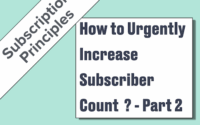The Problem of Canceled Subscriptions – Part 2
In the first part of this article we saw the types of questions that canceled subscriptions raise and the use cases. In this second part, we will consider solutions and give our recommendations. before.
3. The problems, the solutions, the recommendations 🛠️ ✅
Subscriptions sold and then canceled pose problems because
- They existed and generated bookings and costs (transaction fees, acquisition costs)
- They no longer exist and must not distort KPIs such as bookings and the number of subscriptions to renew
- They have no chance of being renewed. They are no longer part of the retention opportunity.
Everyone will choose the solution that seems best suited to their business and reporting. However, it is ideal to be able to:
- Distinguish between subscriptions canceled right after acquisition/renewal and those canceled between the 2nd and 11th month
- Have a filter on these 2 tags in the reporting system
- Filter all canceled subscriptions for the calculation of the future retention opportunity (number of subscriptions to renew)
- Filter subscriptions canceled right after Acquisition/renewal but keep the canceled subscriptions (and refunded pro rata) for the calculation of the retention rate since the latter had a real existence
Pro rata refunds do not affect the revenue but only the booking.
Indeed, when a subscription is canceled after 6 months, half of the initial booking has been recognized over 6 months (or 2 quarters). The other half is returned and is not recognized.
To calculate the refund rate, I recommend:
- To perform a calculation by splitting monthly and annual subscriptions
- To use the calculation formula: total number of cancelled subscriptions divided by total number of subscriptions
- To convert subscriptions cancelled between the 2nd and 11th month into terminated monthly subscriptions (not renewed) to simplify the calculations.
This assumes that
- The information system is capable of transforming an annual subscription into a monthly subscription
- The number of cancellations between the 2nd and 11th month does not represent a significant portion
Finally, we apply GDPR best practices.
When a subscription is canceled, the subscriber is no longer a customer. We only communicate with them if they gave their consent to receive marketing messages. If they become subscriber again 2 weeks later, we can say “welcome back”. If they become subscriber again 2 years later, we are supposed to have forgotten them.
👉 Key takeaways 👉
- The subscription management system must be able to tag canceled subscriptions according to use cases
- The reporting system must allow to filter out canceled subscriptions according to the KPIs to be extracted
- A canceled subscription is a subscription that cannot be renewed. It is also a subscriber with whom we can no longer communicate.



